Cite this document
(“An Analysis of DOLLS HOUSE Research Paper Example | Topics and Well Written Essays - 1750 words”, n.d.)
An Analysis of DOLLS HOUSE Research Paper Example | Topics and Well Written Essays - 1750 words. Retrieved from https://studentshare.org/literature/1463627-an-analysis-of-dolls-house
An Analysis of DOLLS HOUSE Research Paper Example | Topics and Well Written Essays - 1750 words. Retrieved from https://studentshare.org/literature/1463627-an-analysis-of-dolls-house
(An Analysis of DOLLS HOUSE Research Paper Example | Topics and Well Written Essays - 1750 Words)
An Analysis of DOLLS HOUSE Research Paper Example | Topics and Well Written Essays - 1750 Words. https://studentshare.org/literature/1463627-an-analysis-of-dolls-house.
An Analysis of DOLLS HOUSE Research Paper Example | Topics and Well Written Essays - 1750 Words. https://studentshare.org/literature/1463627-an-analysis-of-dolls-house.
“An Analysis of DOLLS HOUSE Research Paper Example | Topics and Well Written Essays - 1750 Words”, n.d. https://studentshare.org/literature/1463627-an-analysis-of-dolls-house.


